Background
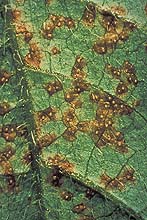
Fig. 1. Dark brown or reddish lesions of soybean rust (courtesy G. L. Hartman) (click image for larger view).
|
|
U.S. crops are susceptible to a large number of diseases caused by fungi, oomycetes, viruses, bacteria, phytoplasmas, and nematodes. Losses due to plant diseases have been estimated to be as high as $30 billion per year (20). Fortunately, not all pathogens of a given crop currently are present in the U.S. Perusal of any Compendium of Plant Disease published by the American Phytopathological Society (APS) will quickly show that there are several serious pathogens that have not yet arrived or have not become established in this country. Other important plant pathogens are found in only limited areas within the country, such that most of the crop is not affected. One example is soybean rust, caused by the fungus Phakopsora pachyrhizi (Figs. 1 and 2). Yield reductions of 10 to 30% on a regional basis are typical in areas where the Asiatic strain is found (27), and yield reductions of over 90% (relative to attainable yields) have been reported for individual fields (14,28). The pathogen has been in Puerto Rico for some time, but the strain is less aggressive than the Asiatic one. However, the Asiatic strain is now in South America.
|
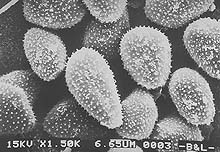
Fig. 2. Urediniospores of the soybean rust fungus P. pachyrhizi. Electron micrograph; scale bar = 6.65 μm (courtesy G. L. Hartman) (click image for larger view).
|
|
Obviously, we can assume that not all exotic plant pathogens will become established and spread if introduced into the U.S. Differences in climate, cropping practices, and local microbial competitors and antagonists all will influence what happens when the pathogen or diseased plant is introduced into a given area. For every chestnut blight, there are probably several “failed” establishments, or establishments with minor economic consequences. Nevertheless, it has been argued that a large fraction of the pathogens of U.S. crops were introduced in modern times from other locations (20,21) and that roughly 65% of crop losses are attributable to introduced pathogens. In one sense, this is not surprising since most crops grown in the country were also introduced from other parts of the world. Deriving statistics such as these is based on many assumptions, that may or may not be justified, but even if the values are rough, there is little doubt that we are vulnerable to plant pathogen introductions.
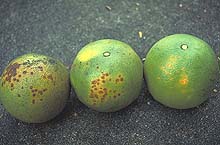
Fig. 3. Immature grapefruit with symptoms of citrus canker. The lesions are estimated to be (left to right) 6 months, 3 months, and 1 month old, demonstrating numerous infection cycles (courtesy T. R. Gottwald) (click image for larger view). |
|
There is a great deal of interest in the threat of invasive species to the U.S. (18,22,23,26). In many ways, the threat is greater now than ever because of increasing international trade and the large numbers of individuals traveling among countries. Plant pathogens comprise just one subset of the many types of invasive species of concern, but this subset is very important economically and politically (13). Citrus canker is a good example of an invasive plant pathogen that has caused economic damage (Fig. 3). The disease was discovered near Miami in 1995, likely due to an accidental introduction 2 years earlier. Canker has now spread to about 1000 square miles of southern Florida (24). The eradication effort has cost over $200 million and the disease is still spreading because tree destruction programs have been successfully challenged in court (at least at this point in time). Other recent examples of plant pathogen introductions include Karnal bunt of wheat (Fig. 4) and plum pox of stone fruits (Fig. 5) (7,15). The Karnal bunt case is interesting because the disease has virtually no impact on crop production, yet is important because of international trade restrictions on wheat from areas where the disease occurs.
|
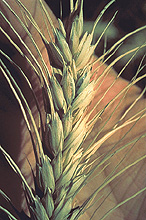
Fig. 4. Wheat head with Karnal bunt infection (courtesy R. M. Bonde) (click image for larger view).
|
|
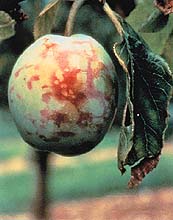
Fig. 5. Fruit symptoms (skin blotches) caused by plum pox virus (plum cv. Czar) (courtesy A. N. Adams) (click image for larger view).
|
|
The World Trade Organization (WTO) was established in 1995 to facilitate international trade by standardizing approaches to certain trade policies and issues. Under the WTO, restrictions on trade must be justified on a scientific basis, rather than being an arbitrary decision by a particular country (12). Regarding pests in general, and plant pathogens in particular, the WTO recognizes the International Plant Protection Convention (IPPC) as the source for international standards for phytosanitary measures affecting trade. Details can be obtained from websites maintained by the Food and Agriculture Organization of the United Nations (10,11).
The threat of the introduction of a nonindigenous plant pathogen is a valid reason for a trade restriction, but the threat must be justified based on potential impact. This puts new pressure on regulatory agencies, such as the USDA Animal and Plant Health Inspection Service (APHIS), to develop sound and defendable regulations. APHIS routinely conducts thorough risk assessments for selected pathogens and commodities, but there are many potentially threatening plant pathogens of U.S. crops, and such detailed analysis could not be done on every nonindigenous pathogen (at least in a short amount of time).
It would be very informative to have a list of pathogens that pose a threat to U.S. crops (13). Such a list could focus the attention of APHIS and suggest the need for detailed risk assessments, which possibly could lead to changes in trade regulations. The list also could serve as an alert to plant pathologists around the world that some diseases are considered to be of importance, at least by the group making the list. The list could be a useful tool to suggest future research, to either support or refute the pathogen selections. As a scientific organization, APS contains experts on all pathogens of U.S. crops, whether the pathogens currently exist in the U.S. or not. A list of threatening plant pathogens could certainly be prepared using this collective expertise. A list such as this must always be a ‘living’ list, however, because pathogens should be either added or deleted, as new information becomes available. The challenge is preparing the list in the first place, and deciding on what criteria should be used to put a particular plant pathogen on the list
An ad hoc committee of APS was formed in 1999 to address the issue of emerging plant diseases and threatening pathogens. This article, written on behalf of the committee, contains a brief review of the committee’s activities related to threatening plant pathogens and the development of tentative pathogen lists.
Activities of the APS ad hoc Committee
• The committee met by conference call a few times to develop a strategy for identifying threatening plant pathogens.
• A request was sent out to APS members, by email as part of an APS News Capsule, requesting suggestions of threatening nonindigenous plant pathogens.
• A tentative list was prepared based on the email responses, a previous list of threatening nonindigenous plant pathogens prepared by the APS Office of International Programs (OIP), and previous lists prepared by APHIS. Members of the committee added additional pathogens.
• The committee met in August of 2000 in New Orleans before the APS Annual Meeting to develop a plan for rating the plant pathogens and preparing a “final” list.
• A (less) tentative list was sent in the Fall of 2000 by email to plant pathology departments for feedback. The committee requested that the department head/chair forward the list to the relevant experts within the department. Feedback was received from several departments.
• The committee members rated the pathogens on a 0-to-3 scale: 0, no threat at all if introduced; 1, small threat (could have some economic impact if not controlled); 2, moderate to large threat; and 3, must be kept out at all costs. Average scores were calculated. Suggested pathogens with low scores were eliminated.
• The list (with ratings averaged) was sent in June 2001 to several APS subject matter committees and OIP for feedback. The committee also sent the list to many of the authors and editors of Compendia of Plant Disease published by APS for feedback.
• The ad hoc committee met in Salt Lake City (August 2001) to discuss the progress to date, and develop plans for determining a final list (at least for this point in time). It was decided to incorporate the suggestions from the various groups, attempt to identify the most serious threats of those listed, and make the information available on APSnet for comment.
It should first be noted that the committee used a very general rating scale in the preliminary scoring of pathogens. This, of course, is not the only possible scale or means of assessing risk (1,19,25). APHIS bases its analyses on a generic pest risk assessment protocol (19), that explicitly takes into account issues such as probabilities of introduction, spread, economic consequences, as well as other considerations. Depending on the nature of the problem addressed, the risk assessment may follow any of several formats. Some examples can be found on websites maintained by APHIS (2,3,4,5,6).
All of the issues addressed by these various risk-assessment protocols are important for regulatory and policy-setting agencies. However, it was felt that using a more general scoring, based on a 0-3 scale, would be less cumbersome for committee members and other experts to use for a large number of candidate pathogens. The actual mean scores are not given here, because these are not meant to be precise or quantitative measures of threats, but are instead meant to focus the attention of the committee regarding major and minor threats.
The committee did not focus on commodities per se, and did not use any information on volume of trade between the U.S. and a country with a serious nonindigenous plant pathogen. Rather, the committee focused, in a general sense, on the epidemiology of the diseases caused by nonindigenous pathogens and the effects of these diseases on the quantity and quality of yield losses. Several potential candidates for the list were eliminated based on low scores.
A decision was made at the APS meeting in Salt Lake City to prepare two lists of threatening pathogens:
(1) Plant pathogens not believed to be in the U.S. at this time; and
(2) Plant pathogens of very limited distribution within the U.S., such that the disease does not currently affect most of the crop and containment/eradication may still be possible.
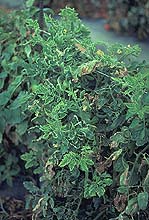
Fig. 6. Tomato plant (cultivar Sanibel) infected with tomato yellow leaf curl virus in Florida (see Table 2). Courtesy J. E. Polston (click image for larger view). |
|
For the second list, distribution is defined relative to the geographic distribution of the crop. For instance, if a disease were found only in two states, this would not be considered “very limited distribution” for a crop grown in only these same states. The U.S. is defined as all 50 states and the neighboring territories. Thus, if a pathogen is present only in Hawaii or Puerto Rico, it is considered to be in the U.S. The committee considers the pathogens on both lists to be important.
Obviously, pathogen membership on either list is a dynamic situation, and there is probably no such thing as a final list or collection of lists. Table 1 and Table 2 (provided here as one PDF file) contain the results of the committee’s deliberations as of 25 September 2001. These can be considered tentative lists. Some of the pathogens listed are indicated with an asterisk. These were considered by the committee to be of greatest (potential) threat to the U.S. These selections were based on a vote by the committee after the Salt Lake City meeting, with general consideration given to the economic importance of the crop, capability of the pathogen to survive, potential for rapid increase over time and spread in space, potential impacts on yield, and difficulty in controlling the disease with available technologies. This approach comprises a type of “expert panel’” method of risk analysis (25). There is an exception to the use of voting by the ad hoc committee for identifying the most serious threats. The APS Forest Pathology Committee chose most of the tree diseases listed (indicated with a ‘+’); thus, this subject matter committee prioritized their list before the ad hoc committee received the information. The ad hoc committee considers all these pathogens to be great threats to U.S. trees.
Challenge to the Reader
The tentative lists of threatening plant pathogens given in Tables 1 and 2 are for your information. The committee hopes that you read through the lists and give us your feedback using the online discussion area [no longer active] established especially for this APSnet Feature story. We fully expect that some of you will disagree with the choices. You may feel that some pathogens should not be listed, and that some omitted pathogens should be listed. In both cases, please give the reasons for your remarks. These tentative lists will become “final”, at least for Fall 2001, after the committee considers any feedback received.
Concluding Comments
As discussed above, it is difficult to make threatening pathogen lists for crops and forests. There have been efforts in the past to rate nonindigenous plant pathogens, and even predict those that will most likely become established in the U.S. within a few years (16). The predictions on establishment have not necessarily been very accurate (13), even when serious pathogens are identified. That is why the committee is taking a general approach to list-making, with requests for input from many sources. It is hoped that a permanent mechanism can be established within APS to maintain these lists, with periodic updates, as more information becomes known.
The next step will be to do a more thorough evaluation of the plant pathogens identified as the most serious threats on the “final” (Fall 2001) lists. This, most likely, is a project for APHIS and not APS or the ad hoc committee. Also needed is an interactive database, available on the Internet, for the routine reporting of emerging and re-emerging diseases of plants. Of note is the existing National Agricultural Pest Information System, the online database used to support the national U.S. Cooperative Agricultural Pest Survey program (17). The European and Mediterranean Plant Protection Organization (EPPO) also actively maintains lists of quarantine-significant plant pathogens (8,9). What is lacking is an ongoing dialogue within a scientific venue for scientists within the research community, industry, regulatory agencies, and foreign countries to discuss threatening plant pests. This broad, continuing discussion will be a great potential value in identifying new threats to U.S. crops and forests.
Additional Resources
USDA Animal and Plant Health Department
USDA Foreign Agricultural Service
European and Mediterranean Plant Protection Organization
Food and Agriculture Organization of the United Nations
NAPIS Pest Tracker
The National Invasive Species Council
References
1. Anonymous. 1996. International standards for phytosanitary measures, Part 1-Import regulations; Guidelines for pest risk analysis. Secretariat of the International Plant Protection Convention, Food and Agriculture Organization of the United Nations, Rome. 19 pp.
2. APHIS. 1995. Importation of Avocado Fruit Importation of Avocado Fruit (Persea americana) from Mexico Supplemental Pest Risk Assessment. Online. USDA Animal and Plant Health Inspection Service, Plant Protection and Quarantine.
3. APHIS. 1996. Penjing plants from China: pest risk assessments. Online PDF. USDA Animal and Plant Health Inspection Service, Plant Protection and Quarantine.
4. APHIS. 2000. Guidelines for pathway-initiated pest risk assessments. Online PDF. USDA Animal and Plant Health Inspection Service, Plant Protection and Quarantine. Version 5.02.
5. APHIS. 2000. Pest risk assessment for importation of solid wood packing materials into the United States. Online. USDA Animal and Plant Health Inspection Service, Plant Protection and Quarantine.
6. APHIS. 2000. Pest Risk Assessment: Importation of Adult Queens, Package Bees and Germplasm of Honey Bees, Apis mellifera L., From Australia. Online. USDA Animal and Plant Health Inspection Service, Plant Protection and Quarantine.
7. Bonde, M. R., Peterson, G. L., and Schaad, N. W. 1997. Karnal bunt of wheat. Plant Disease 81:1370-1377.
8. EPPO. 2001. EPPO Alert List. Online. European and Mediterranean Plant Protection Organization.
9. EPPO. 2001. EPPO Standard PM1/2(9) A1 and A2 Quarantine Lists. Online. European and Mediterranean Plant Protection Organization.
10. FAO. 1995. International standards for phytosanitary measures: Principles of plant quarantine as related to international trade. Online. Food and Agriculture Organization of the United Nations. World Agricultural Information Centre (WAICENT). Publication No. 1, February 1995.
11. FAO. 1997. International Plant Protection Convention: New Revised Text. Online. Plant Protection Service (AGPP), Food and Agriculture Organization of the United Nations. World Agricultural Information Centre (WAICENT).
12. FAS. 2001. The World Trade Organization and U.S. Agriculture. Online. USDA, Foreign Agricultural Service. FASonline, Fact Sheet, March 2001.
13. Kingsolver, C. H., Melching, J. S., and Bromfield, K. R. 1983. The threat of exotic plant pathogens to agriculture in the United States. Plant Dis. 67:595-600.
14. Kuchler, F., Duffy, M., Shrum, R. D., and Dowler, W. M. 1984. Potential economic consequences of the entry of an exotic fungal pest: the case of soybean rust. Phytopathology 74:916-920.
15. Levy, L., Damsteegt, V., Scorza, R., and Kolber, M. 2000. Plum pox potyvirus disease of stone fruits. Online. APSnet Feature, March 2000. American Phytopathological Society, St. Paul, MN.
16. McGregor, R. C. 1973. The emigrant pests. Mimeo. Rep. U.S. Dep. Agric. 167 pp.
17. NAPIS. 2001. Home page. Online. National Agricultural Pest Information System.
18. National Invasive Species Council. 2001. Invasivespecies.gov (home page). Online. National Agricultural Library, USDA.
19. Orr, R. L., Cohen, S. D., and Griffin, R. L. 1993. Generic non-indigenous pest risk assessment process. Animal and Plant Health Inspection Service, U.S. Department of Agriculture. 40 pp.
20. Pimentel, D., Lach, L., Zuniga, R., and Morrison, D. 2000. Environmental and economic costs associated with non-indigenous species in the United States. BioScience 50:53-65.
21. Pimentel, D. 1993. Habitat factors in new pest invasions. Pages 165-181 in: Evolution of Insect Pests-Patterns of Variation. K. C. Kim, and B. A. McPheron, editors.
22. Schmitz, D. C., and Simberloff, D. 1997. Biological invasions: A growing threat. Issues in Science and Technology 13:33-40.
23. Schmitz, D. C., and Simberloff, D. 2001. Needed: A national center for biological invasions. Issues in Science and Technology 17:57-62.
24. Schubert, T. S., Rizvi, S. A., Sun, X., Gottwald, T. R., Graham, J. H., and Dixon, W. N. 2001. Meeting the challenge of eradicating citrus canker in Florida-Again. Plant Disease 85:340-356.
25. Teng, P. S., and Yang, X. B. 1993. Biological impact and risk assessment in plant pathology. Annu. Rev. Phytopathol. 31:495-521.
26. White House. 1999. Invasive species. Executive Order 113112, The White House Office of Press Secretary. February 3, 1999.
27. Yang, X. B., Dowler, W. M., and Royer, M H. 1991. Assessing the risk and potential impact of an exotic plant disease. Plant Disease 75:976-982.
28. Yang, X. B., Dowler, W. M., Tschanz, A. T., and Wang, T. C. 1992. Comparing the effects of rust on plot yield, plant yield, yield components, and vegetative parts of soybean. J. Phytopathol 136:46-56.
Acknowledgments
I thank all the members of the ad hoc committee for their many valuable contributions: A. Vidaver, M. Bonde, V. Damsteegt, R. Forster, F. Nutter, J. Beale, J. Polston, M. Royer, OW Barnett, H. Scherm, S. Redlin, S. Shafer. S. Tolin, and D. Opgenorth. I also thank the Forest Pathology committee for its work on developing the tree pathogen list. Additional valuable contributions were made by B. Singh, S. A. Rizvi, R. Frederick, T. Boratynski, R. Bennett, L. Haugen, and C. Krass.
